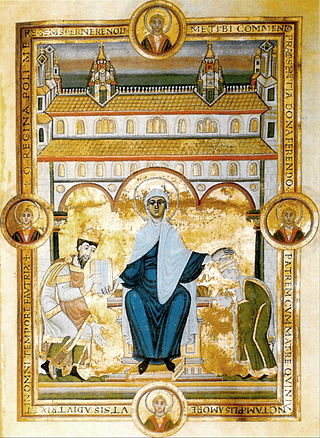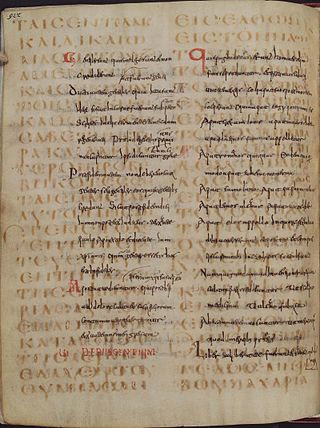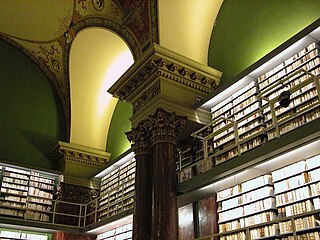
Braunschweig or Brunswick is a city in Lower Saxony, Germany, north of the Harz Mountains at the farthest navigable point of the river Oker, which connects it to the North Sea via the rivers Aller and Weser. In 2024, it has a population of 272,417. The urban agglomeration of Braunschweig has an estimate population 476,000 during the year 2024.

Henry the Lion, also known as Henry III, Duke of Saxony and Henry XII, Duke of Bavaria, was a member of the Welf dynasty.

Wolfenbüttel is a town in Lower Saxony, Germany, the administrative capital of Wolfenbüttel District. It is best known as the location of the internationally renowned Herzog August Library and for having the largest concentration of timber-framed buildings in Germany, around 1,000. It is an episcopal see of the Evangelical Lutheran Church in Brunswick. It is also home to the Jägermeister distillery, houses a campus of the Ostfalia University of Applied Sciences, and the Landesmusikakademie of Lower Saxony.

The Duchy of Brunswick was a historical German state that ceased to exist in 1918. Its capital was the city of Brunswick. It was established as the successor state of the Principality of Brunswick-Wolfenbüttel by the Congress of Vienna in 1815. In the course of the 19th-century history of Germany, the duchy was part of the German Confederation, the North German Confederation and from 1871 the German Empire. It was disestablished after the end of World War I, its territory incorporated into the Weimar Republic as the Free State of Brunswick.

Heldenbücher is the conventional title under which a group of German manuscripts and prints of the 15th and 16th centuries has come down to us. Each Heldenbuch contains a collection of primarily epic poetry, typically including material from the Theodoric cycle, and the cycle of Hugdietrich, Wolfdietrich and Ortnit. The Heldenbuch texts are thus based on medieval German literature, but adapted to the tastes of the Renaissance.

The Herzog Anton Ulrich Museum (HAUM) is an art museum in the German city of Braunschweig, Lower Saxony.

The University of Helmstedt was a university in Helmstedt in the Duchy of Brunswick-Wolfenbüttel that existed from 1576 until 1810.
Helmarshausen Abbey was a Benedictine monastery situated in the small town of Helmarshausen, now part of Bad Karlshafen in Hesse, Germany.

The Golden Gospels of Henry III, also Codex Aureus of Speyer or Speyer Gospels, is an eleventh-century illuminated Gospel Book. The manuscript contains the Vulgate versions of the four gospels plus prefatory matter including the Eusebian canon tables. It was probably produced at the Abbey of Echternach under the patronage of Henry III, Holy Roman Emperor. In 1046, Henry donated the manuscript to Speyer Cathedral in Germany to commemorate the dedication of the cathedral's high altar.

Quedlinburg Abbey was a house of secular canonesses (Frauenstift) in Quedlinburg in what is now Saxony-Anhalt, Germany. It was founded in 936 on the initiative of Saint Mathilda, the widow of the East Frankish King Henry the Fowler, as his memorial. For many centuries it and its abbesses enjoyed great prestige and influence. Quedlinburg Abbey was an Imperial Estate and one of the approximately forty self-ruling Imperial Abbeys of the Holy Roman Empire. It was disestablished in 1802/3. The church, known as Stiftskirche St Servatius, is now used by the Lutheran Evangelical Church in Germany.

Codex Guelferbytanus A designated by Pe or 024, ε 33, is a Greek uncial manuscript of the Gospels, dated palaeographically to the 6th century. The manuscript is very lacunose.

The Herzog August Library, in Wolfenbüttel, Lower Saxony, known also as Bibliotheca Augusta, is a library of international importance for its collection from the Middle Ages and early modern Europe. The library is overseen by the Lower Saxony Ministry for Science and Culture.

Codex Guelferbytanus B,, designated by Q or 026, ε 4, is a Greek uncial manuscript of the Gospels, dated palaeographically to the 5th century. It is a palimpsest.

Codex Carolinus is an uncial manuscript of the New Testament on parchment, dated to the 6th or 7th century. It is a palimpsest containing a Latin text written over a Gothic one. The Gothic text is designated by siglum Car, the Latin text is designated by siglum gue or by 79, it represents the Old Latin translation of the New Testament. It is housed in the Herzog August Library in Wolfenbüttel in Lower Saxony, Germany.
Franz Anton Knittel was a German, Lutheran orthodox theologian, priest, and palaeographer. He examined palimpsests' text of the Codex Guelferbytanus 64 Weissenburgensis and deciphered text of Codex Carolinus. He was the author of many works.

The Brunswick Lion is a medieval sculpture, created in bronze between 1164 and 1176, and the best-known landmark in the German city of Brunswick. The Brunswick Lion was originally located on the Burgplatz square in front of the Brunswick Cathedral. The monument was moved to Dankwarderode Castle in 1980, and later replaced at the original location by a replica. Within Brunswick, it is commonly known as the "Castle Lion" (Burglöwe).

The Guelph Treasure is a collection of medieval ecclesiastical art originally housed at Brunswick Cathedral in Braunschweig, Germany. The Treasure takes its name from the princely House of Guelph of Brunswick-Lüneburg.

The Liuthar Gospels are a work of Ottonian illumination which are counted among the masterpieces of the period known as the Ottonian Renaissance. The manuscript, named after a monk called Liuthar, was probably created around the year 1000 at the order of Otto III at the Abbey of Reichenau and lends its name to the Liuthar Group of Reichenau illuminated manuscripts. The backgrounds of all the images are illuminated in gold leaf, a seminal innovation in western illumination.

The Marienkirche is a main church (Hauptkirche) in Wolfenbüttel, Lower Saxony, Germany. The official name of the Lutheran church is Hauptkirche Beatae Mariae Virginis. Short common names are Hauptkirche BMV, or simply BMV. It is regarded as the first major Protestant church. It was commissioned by Henry Julius, Duke of Brunswick-Lüneburg. Building began in 1608, directed by Baumeister Paul Francke. The portals in the north and south are attributed to Jacob Meyerheine.
Heinrich Sievers was a German musicologist, music critic, university lecturer, and conductor. He was regarded as an authority on the history of music in Hanover and Lower Saxony, and wrote music-historical monographs in English and Finnish publications.


















